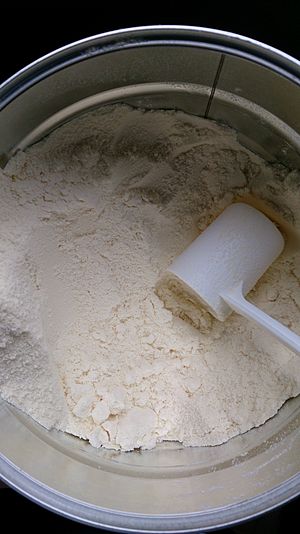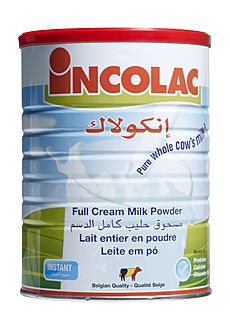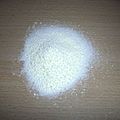Milk powder facts for kids
Milk powder is a powder made by taking all the water out of milk. When you add water back, it becomes liquid milk again! People often use milk powder in places where it's hard to keep fresh milk cold, like in countries without many refrigerators. It's also super handy for cooking and baking.
How Milk Powder Was Invented and Made

Long ago, even Marco Polo wrote about Mongolian soldiers who carried sun-dried skimmed milk as a kind of paste. But the first modern way to make dried milk was thought up by a Russian doctor named Osip Krichevsky in 1802. Later, in 1832, a Russian chemist named M. Dirchoff started making it for sale.
Today, most milk powder is made using a method called spray drying. First, fresh milk is pasteurized (heated to kill germs). Then, a lot of its water is taken out, making it thicker. This thick milk is then sprayed into a very hot room. The tiny drops of milk instantly dry up, leaving behind fine milk powder.
Another way to make it is called drum drying. Here, milk is spread in a thin layer onto a hot spinning drum. The milk dries quickly, and then it's scraped off. However, milk made this way can sometimes taste a bit "cooked" because of the heat.
There's also freeze drying, which is a gentle way to dry milk. This method helps keep more of the good stuff, like nutrients, in the milk compared to drum drying.
The way milk powder is made and how much heat is used can change how it acts. For example, it can affect how well it dissolves in cold water, its taste, and how much space it takes up.
Using Milk Powder for Food and Health
Milk powder is used in many different foods. It's a key ingredient in infant formula (baby milk). It's also used to make yummy confectionery like chocolate and caramel candy. When you're baking, adding milk powder can make your baked goods just right, especially if adding liquid milk would make them too runny.
In places like India, milk powder is used to make popular sweets such as gulab jamun (milk balls) and chum chum (a sweet often sprinkled with coconut). If you're making a no-cook recipe with nut butters, milk powder can help soak up extra oil and keep things from getting too oily.
Milk powder is also very important for UN food aid and in places where fresh milk isn't available, like in fallout shelters or emergency supplies. It's great for developing countries because it's lighter and smaller to transport, and it doesn't need to be kept cold. Just like other dry foods, it lasts a long time. This makes it a favorite for survivalists, hikers, and anyone who needs food that's easy to carry and prepare.
Images for kids




